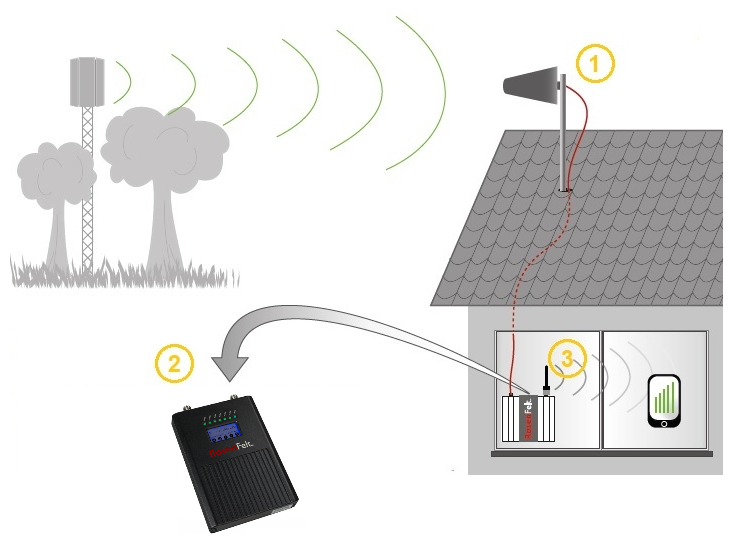
In 2016, politicians determined that mobile telephony, that is, wireless communication and telephone reception, are fundamental to the economy and society. Therefore, it is no longer considered "nice to have", but "necessary to have". But even today, the reality is that in many homes there is not enough phone coverage to make calls or surf the Internet. This problem is not only prevalent in new and well-insulated buildings, but also in remote areas and it often happens that calls are dropped. In this article we will answer the following question: "Why is mobile phone coverage bad and what can you do about it? "
- 1. How do I know if I have poor phone coverage in my home?
- 2. Why don't I have mobile coverage at home?
- 3. How can the signal be improved?
- 4. Which amplifier do I need?
- 5. What should I pay attention to when installing a mobile signal repeater?
1. How do I know if I have poor phone coverage in my home?
You know very well that you have a bad signal at home when you cannot make phone calls without being interrupted, the calls do not reach your phone and / or the signal you have on the phone outside is not the same as inside. In that case, you have a bad connection and you cannot understand your interlocutor or he cannot understand you. Most of the time, mobile internet is also very slow or non-existent. The place where you can make calls or surf the web with your mobile is right at your window.
The number of bars on your mobile phone indicates the quality of mobile coverage. In the photo below you can see that there are no bars and it shows "no net".

With your Android smartphone, you can measure mobile phone reception using an app. You can download the following application on your Android phone: https://play.google.com/store/apps/details?id=com.parizene.netmonitor&hl=nl

With this application you can see:
- The strength of the reception
- Where is the transmission tower located
- The signal being received (2G, 3G or 4G LTE)

2. Why don't I have mobile coverage at home?
The providers strive to provide the availability of mobile communications "anytime, anywhere" in Europe. To measure whether the coverage is sufficient, we take the external signal as a basis. Operators define a coverage requirement for each region.
If the region consists mainly of a large urban area, there is a high network density (and therefore good coverage), on the other hand, the installation of transmission towers in a rural area may be more difficult, due to special conditions like great natural reserves. Environmental factors such as weather and nature also influence reception in a home on your telephone network.
A.There is no mobile phone coverage in urban areas
Poor mobile coverage in large metropolitan areas occurs mainly in new buildings or basements, garages and underground buildings. Providers cannot guarantee internal coverage. Due to modern insulation standards designed to reduce household energy consumption, the GSM telephone network cannot penetrate all walls or windows. Often a kind of cage is created, a kind of construction that prevents the entry of static fields. It often happens that the GSM signal in the attic or on the upper floors is still reasonable to good. Typically, the higher it is, the better the phone coverage.
B. There is no mobile phone coverage outside of urban areas
The lack of coverage outside urban areas is mainly due to terrain conditions. For example, there are nature reserves where transmission towers cannot be installed. Also, the trees absorb the mobile signal very strongly, which weakens the coverage.
3. How can the signal be improved?
Here we explain how you can improve mobile phone coverage with a GSM repeater. If a GSM signal can be received, even a weak one (outside), it can be carried inside your home. GSM REPEATER SHOP offers GSM repeaters that come with an indoor antenna, an outdoor antenna and 10 meters of coaxial cable to connect it. The outdoor antenna is mounted as high as possible in the direction of the transmission tower. For example, on the roof or on the top of the facade. The indoor antenna simply mounts to the repeater in the case of the whip antenna, but you can customize your order to put a different indoor antenna inside. The GSM repeater is connected to the current.

4. Which amplifier do I need?
5. What should I pay attention to when installing a mobile signal repeater?
It is recommended to do a trial installation first. It is important that there is no feedback (interference) between the antennas. If an indoor antenna is installed too close to the outdoor antenna, the repeater turns itself off. For example, make sure the indoor antenna is not installed too close to a window.
TIt is also important that the outdoor antenna is installed correctly. That is, as high as possible in the direction of the transmission tower. If this is not done, the signal will not be received optimally. This means that the GSM signal is not optimally amplified. Not sure where the corresponding transmitter mast is? Contact us, we will be happy to help you.


